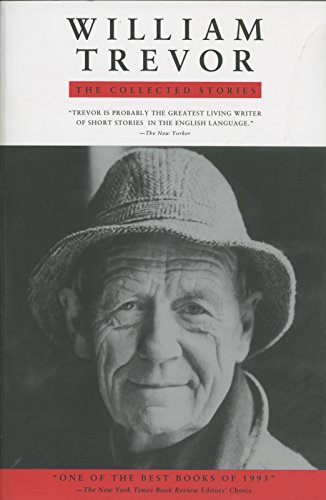Is this the first happy ending in The Collected William Trevor? Looking back through the table of contents, I think it is. Arguably, “Lovers of Their Time” has a happy ending of sorts, with Norman secure in his sense that he’d had one great love affair in his life, though its unclear how seriously we’re meant to take this considering the affair was conducted in a hotel bathroom. It’s somewhat incredible to realize that “The Time of Year” is the first story out of the 57 I’ve so far read and written about in the Collected that offers an unvarnished and unironic (though muted and dark—this is still Trevor, after all) happy ending.
Valerie Upcott is a student at Trinity College in Dublin. The story takes place over the course of an evening at her history teacher’s house, where Professor Skully and his wife ritually hold a bleak end-of-term pre-Christmas party that no one wants to attend. Valerie least of all, as the Christmas season—“the time of year”—finds her depressed and withdrawn, unavoidably reminded of what happened when she was 14, six years earlier: she talked a boy she loved into going swimming on Christmas Day, and he drowned in the frigid Irish surf.
Reluctantly, Valerie attends the party, where we see the other attendees through her eyes: insecure Kilroy drinking on the sly; unremarkable Yvonne being talked to by the insufferable but remarkably named Bewley Joal; the pretty O’Neill twins being followed by their cadre of admirers; the maritorious Honor Hitchcock sitting with her luxurious fiancee, the Reverend; Ruth Cusper still in her motorcycle gear; the boring A-students Woodward, Whipp, and Woolmer-Mills hanging on the boring Professor’s every word; et cetera. Valerie lavishes particularly acute attention on the Professor and his wife, Mrs. Skully and she wonders:
How could that mouth open and close, issuing invitations without knowing they were the subject of derision? How could this woman, in her late middle age, officiate at student parties in magenta and jade, or bake inedible cakes without knowing it? How could she daily permit herself to be taken for granted by a man who cared only for students with academic success behind them? How could she have married his pomposity in the first place? There was something wrong with Mrs. Skully, there was something missing, as if some part of her had never come to life.
Valerie has a similar sense of the other students, a comfortable obliviousness about their own lives and characters that will propel them into mostly unexceptional, and in some cases terrible, future lives. In this Muriel Spark-esque section, she imagines most of their lives, from childhood to senescence, the way they are all unthinkingly trapped in themselves. And as she returns to her residence hall, she finds herself thus comforted: “She had been wrong to imagine she envied other people their normality and good fortune. She was as she wished to be.” She understands that her adolescent tragedy has made her more sensitive and self-aware than others, and in this she finds “what appeared to be a hint of comfort.”
As happy endings go, this is not wildly happy, but Valerie is ultimately offered comfort that is in surpassingly short supply in the Trevor universe. Indeed, Trevor’s modus operandi might be said to be a withholding of comfort—his characters are typically stripped of whatever paltry comfort they’ve been able to rig up in their unfortunate lives, and we usually leave them shivering in the naked wind of narrative truth. Here we have the opposite: a character who has suffered tragedy, who for years has found no bulwark against its seasonal encroachment on her spirit, and who at last finds relief in how this tragedy may ultimately shape her life. This is real succor, too—measured and clear-eyed—not the delusional relief Trevor’s characters typically find in nostalgia and fantasy and alcohol.
While it’s funny and slightly alarming to note that the first happy ending appears on page 800 of the Collected, it isn’t entirely surprising either. The short story, as I have said before in this column, as I say to my classes, is typically a sadistic art form. Constrained by space, the short story writer must locate problems, conflict, sadness, as a Lagotto Romagnolo roots out truffles. My students sometimes ask why most of the stories we read are depressing and tragic, and my unsatisfying, tautological answer is that it’s an art form that rewards tragedy. And I think this is an incomplete and perhaps slightly dishonest answer. The truth is, it can be easy to adopt a punitive mode of storytelling, one in which our characters are constantly subjects, constantly flailing around in the darkness, a darkness that holds partial appeal for the writer because it may feel the most life-like, the most like life. But this impulse can become a reflex, a grim tic. We should hold out the possibility of redemption and renewal, because these are things that happen in life, too.









